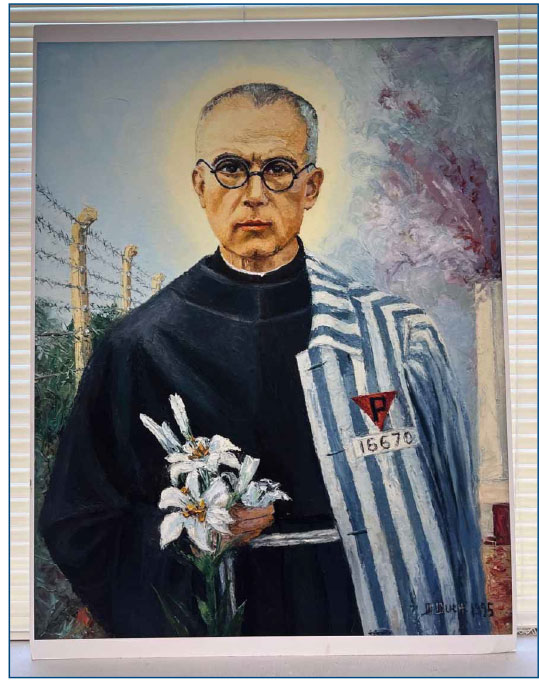Father Maximilian Kolbe arrived at Auschwitz from Pawiak prison in Warsaw, Poland on May 28, 1941. He was already a well-known Franciscan priest, editor, and founder of the City of the Immaculata, Niepokalanów in Polish, a sprawling friary and publishing apostolate. Upon his arrival at Auschwitz, he was labeled prisoner number 16670. In the camp he was sentenced to punishing manual labor. He carried sacks, hauled stones, cleared reeds, and dug trenches from before sunrise until after sunset. At night in the barracks, he fought to preserve the dignity and the humanity of his fellow inmates in Block 14. He shared contraband bread with men who were vanishing physically and spiritually. According to his fellow inmates, he never expressed anger or despair as he modeled patience and compassion despite enduring beatings from guards and fellow prisoners forced to work as kapos. He heard confessions in whispers and blessed the dying with a glance, the only sacrament possible where even religious gestures could be fatal.
On a sweltering afternoon in late July 1941, sirens howled through Auschwitz. A man from Kolbe’s barracks was thought to have escaped (it was later discovered that this prisoner had died in the latrine) and the SS guards retaliated with ritual terror of collective punishment. Ten prisoners from Block 14 would be selected randomly to die of starvation in the underground cells of Block 11, the bunker reserved for punishment, torture, and execution. As the condemned men were lined up, one of the condemned men, a Polish soldier named Franciszek Gajowniczek, cried out for his wife and children. Then something unexpected happened inside a system designed to extinguish all hope when Father Kolbe stepped out of formation of the roll call and asked to take the man’s place in starvation cell with the nine other prisoners. The SS officer in charge, Commandant Karl Fritzsch, was astonished that anyone would volunteer to die, and asked who he was, expecting Father Kolbe to say his prisoner number. Instead, Father Kolbe said, “I am a Catholic priest.” Commandant Fritzsch accepted Father Kolbe’s request to take the place of Franciszek Gajowniczek, and he and the nine others were driven to the Block 11, stripped, and sealed in darkness.
 In the starvation cell of Block 11, Kolbe did what he had prepared to do his entire life, he transformed the void into a chapel. Witnesses later recalled that he prayed aloud, led hymns, comforted the suffering, and calmed the dying. Even the guards, hardened by their cruelty, noticed the atmosphere in his cell was different. Instead of wailing and groaning, there was soft singing and gentle words, that attracted other prisoners to listen outside the narrow window. The cell seemed illuminated from within by the shared last breaths of men refusing to let cruelty dictate their final words. After two weeks without food or water, Kolbe was still alive, barely. On August 14, 1941, needing the cell for another group of condemned, an SS man finally ended Father Maximilian Kolbe’s life with a phenol injection. Kolbe’s body was cremated the next day, August 15, 1941, which happened to be the feast of the Assumption. The prisoner he saved, Franciszek Gajowniczek, survived the war and stood in St. Peter’s Square when Pope John Paul II canonized Maximilian Kolbe in 1982, designating him a saint and a “martyr of charity,” which recognized his death by voluntary self-sacrifice to save the life of a stranger as a witness to the commandment to love.
In the starvation cell of Block 11, Kolbe did what he had prepared to do his entire life, he transformed the void into a chapel. Witnesses later recalled that he prayed aloud, led hymns, comforted the suffering, and calmed the dying. Even the guards, hardened by their cruelty, noticed the atmosphere in his cell was different. Instead of wailing and groaning, there was soft singing and gentle words, that attracted other prisoners to listen outside the narrow window. The cell seemed illuminated from within by the shared last breaths of men refusing to let cruelty dictate their final words. After two weeks without food or water, Kolbe was still alive, barely. On August 14, 1941, needing the cell for another group of condemned, an SS man finally ended Father Maximilian Kolbe’s life with a phenol injection. Kolbe’s body was cremated the next day, August 15, 1941, which happened to be the feast of the Assumption. The prisoner he saved, Franciszek Gajowniczek, survived the war and stood in St. Peter’s Square when Pope John Paul II canonized Maximilian Kolbe in 1982, designating him a saint and a “martyr of charity,” which recognized his death by voluntary self-sacrifice to save the life of a stranger as a witness to the commandment to love.
Saint Maximilian Kolbe’s story occupies a unique space in the history of the Holocaust. His actions in Auschwitz reflect the triumph of humanity and compassion in the face of cruelty, persecution, and suffering. His witness proves the victory of individual choices over the machinery of evil and mass atrocity. His life reveals the power of conscience when confronted with tyranny, and his death illuminates the enduring capacity of humans to choose love over fear. He is a reminder that even in the darkest times, self-sacrificial love defies oppression and shapes history.

